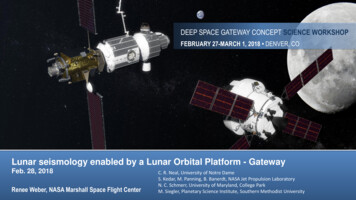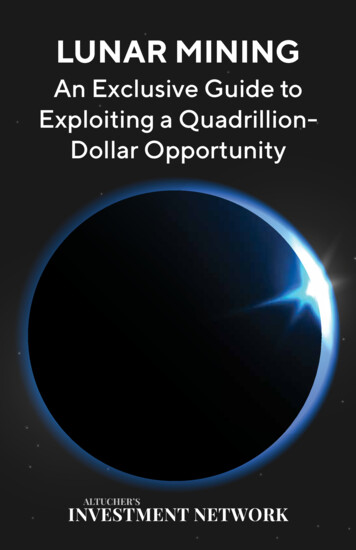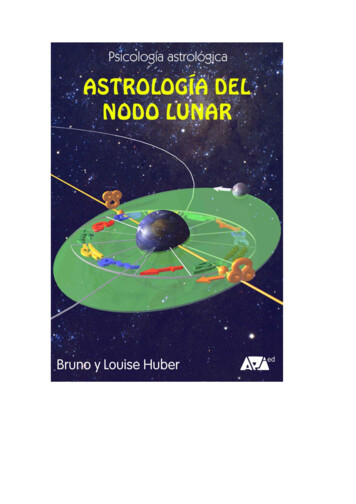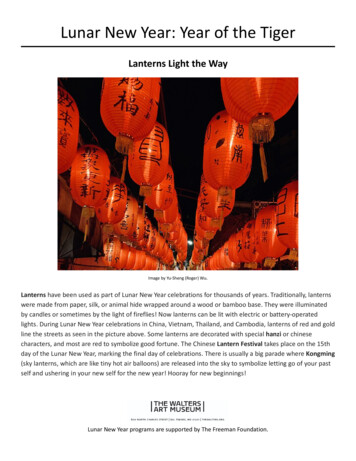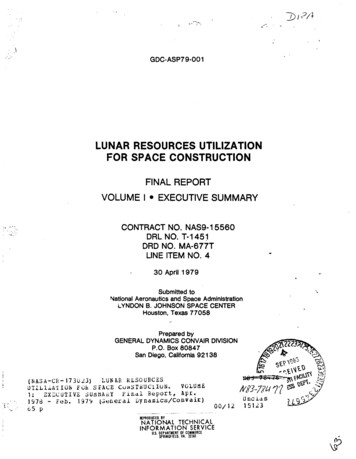
Transcription
.-··.J)1.?/tGDC·ASP79-001LUNAR RESOURCES UTILIZATIONFOR SPACE CONSTRUCTIONFINAL REPORTVOLUME I EXECUTIVE SUMMARY; JCONTRACT NO. NAS9-15560DRL NO. T-145 ORD NO. MA-677TLINE ITEM NO. 4 . .30 April 1 979·.'Submitted to!\lational Aeronautics and Space AdministrationLYNDON B. JOHNSON SPACE CENTERHouston, Texas 77058Prepared byGENERAL DYNAMICS CONVAIR DIVISIONP.O. Box 80847San Diego, California 92138(NASA-CR-173023)LUNAR R.LSOUBCESUill.l A·IION fOh SfACE CuI:CSTiiUC'llON.VOLUMEEX:CUTIVE SUctMA Y Findl Report, Apr.1978 - Feb. 197 ("1eneral Dy namics/Convair)65 pl:- -R P110DUCED BY--"""Unc.i.dS00/12NATIONAL TECHNICALINFORMATION- SERVICEU.S. DEPAR1MENI OF COMMERCESPRINGFIELD. VA. 2216115123
,1{-'.-J-- ,'.·
·-I .,·- . ---,;-· lIr· -·j,. I.,.J''; "'.':- -a. - :".·;- \'rf/·' ll.'i; 'f :t. I.I:JI'I,, ' -·.· '1I,. '»i 1 ii .' .!·1· . i ·- . ·1.::;,lc:' '.t k ; . 1" o:."I .: 'r ·,\"'· .\.;.\ ,.;;.t·---·· .,f.·.,.--,.,,. ·.- "'.,. ,/' -r-- '·. ;·.I·1.,':\i.I··I.'.ri I; ·,'.;;1.),\-.;J·s.' ·:i":.'1·.,,I -i.\,.t ;ttl'i '.'j.·;. -., t;'- , /. :::. - .:--- -. \;/'l/{S ··. -: J t" -- V) r/;:.· 1:--·,· -I i. . . "\ ,,-"' ·· -.,,. ·,·-.,;. :' . { -:--r.,. "'- Ii lt-'\·;.· . 'if!tt;\.' ·,·. j'.:.\Ii. : !r.\·'·';rI.·' /: it. /} 1: .'.; .J!I1.·. :, ,l'Ioli .'.,f.t.iI --(!ii.r; .- 'l! r-:;., J.il.I.Reproduced frombest available copy.i Preceding page blank' ji,;;:ii-.)
FOREWORDThis final report was prepared by General Dynamics Convair Division for NASA/JSCin accordance with Contract NAS9-15560, DRL No. T-1451, DRD No. MA-677T,Line Item No. 4. It consists of three volumes: (I) A brief Executive Summary; (II) acomprehensive discussion of Study Results; and (Ill) a compilation of Appendicies tofurther document and support the Study Results.The study results were developed from April 1978 through February 1979, followed bypreparation of the final documentation. Reviews were presented at JSC on 18 October1978 and 21 February 1979.Participants who significantly contributed to this study include General Dynamics Convairpersonnel, a materials processing and manufacturi11g consultant, and five technicalreviewers who are nationally recognized authorities on lunar materials and/or spacemanufacturing.General Dvnamics ConvairEd BockStudy ManagerMike BurzLane CowgillAndy EvanchoBob RisleyCharley ShawlJoe StreetmanTransportation AnalysisTrajectory AnalysisEconomic AnalysisEconomic AnalysisTransportation SystemsTransportation SystemsMaridee PetersenTyping,(ConsultantAbe Hurlich-;!Material Processing & Manufacturing(Retired Manager of Convair' s Materials Technology Department and past national president of the American Society forMetals.) Technical ReviewersDr. Jim ArnoldGerald DriggersDr. Art DulaDr. John FreemanDr. Gerry O'NeillUniversity of California at San DiegoSouthern-Research InstituteButler, Binion, Rice, Cook & KnappRice UniversityPrinceton Universityiii
In addition to these participants, useful supportive information was obtained from twocomplementary study activities, from personnel at NASA's Johnson Space Center andLewis Research Center, and from many academic and industrial researchers who areinvolved with development of manufacturing processes which may be especially suitedfor in space use. Contract NAS09-051-001 "Extraterrestrial Materials Processing and Construction" being performed by Dr. Criswell of LPI under the direction of JSC'sDr. Williams. Contract NASS-32925 "Extraterrestrial Processing and Manufacturing of LargeSpace Systems" being performed by Mr. Smith of MIT under the direction ofMSFC's Mr. von Tiesenhausen. Earth Baseline Solar Power Satellite costing information from Mr. Harron,Mr. Whittington, and Mr. Wadle of NASA's Johnson Space Center. Ion Electric Thruster information for argon and oxygen propellants providedby Mr. Regetz and Mr. Byers of NASA's Lewis Research Center. Electron Beam Vapor Deposition of Metals Infonm tion from Dr. Schiller ofForschungsinstitut Manfred Von Ardenne, Dresden, and Dr. Bunshah ofUCLA, plus others. Solar Cell Manufacturing Information from Mr. Wald of Mobile Ty o SolarEnergy Corp., Mr. Minnucci and Mr. Younger of SPIRE Corp., and Mr. Dubikof Schott Optical Glass Co. , plus others. Glass Manufacture Using Lunar Materials Information from Dr. MacKenzieof UCLA.The study was conducted in Convair's Advanced Space Programs department, directedby J. B. (Jack) Hurt. The NASA-JSC COR is Earle Crum of the TransportationSystems Office, under Hubert Davis, Manager.For further information contact:Earle M. CruinNational Aeronautics and Space AdministrationLyndon B. Johnson Space CenterTransportation Systems Office, Code ERHouston, Texas 77058(AC713) 483-3083Edward H. BockGeneral Dynamics Convair DivisionAdvanced Space Programs, 21-9500P. O. Box 80847San Diego, California 92138(AC714) 277-8900 x2510iv: )
TABLE OF CONTENTSSection12PageINTRODUCTION1-11.1LUNAR RESOURCES UTILIZATION CONCEPT1-11.2STUDY SCOPE1-11.3OBJECTIVES AND APPROACH1-2STUDY RESULTS2-12.1COMPARISON METHODOLOGY2-12. 2MATERIAL REQUIREMENTS AND SCENARIODEVELOPMENTScenario Development2.2.12. 2. 2Earth Construction ··-·,.-.Materials-;;·- --:-2.2.3Lunar Material Substitutions2.2.4LRU SPS Material Requirements2-42-42-62-72-7- --'""· --2. 3,-.··,('.,-.2.4-2.5LRU SYSTEMS CONCEPT DEFINlTION2. 3.1Concept DefinitionsEarth Material Requirements Development &2. 3. 2Comparison2.3.3Element DefinitionMaterial Characterization2. 3.4Start-up2. 3. 52-92-10ECONOMIC ASSESSMENTCost Analysis2. 4.1Threshold Sensitivity to Manufacturing Costs2. 4. 2Cost Uncertainty Analysis2. 4. 3Program Funding Schedule and Present Value2.4.4Analysis2-302-312-372-38PROGRAMMATICS2. 5.1LRU DeveloJ mel!t PPl:" ?achRecommended Subsequent Study Tasks2. 5. 2RecommendedTechnology -Development Tasks2. s. 3. . . --2-432-432-472-48' "3--.-- CONCLUSlONS & LUSCONS3-13. 2RECOMMENDATIONS3-3.44-1REFERENCESv
"' '')ILIST OF 122-132-142-152-162-17PageReference taseline solar power sat 0 1 te.Space construction concepts.Earth baseline steady state material requirements.Representative LRU system elements.Scope of processing and manufacturing operations.LRU transportation benefit.Material characterization for LRU Concept BMaterial characterization for LRU Concept CStart-up mass estimate for LRU Concept B.Earth launched payload comparison.SPS summary work breakdown structure.Nominal economic threshold of LRU concepts.Nominal economic threshold for LRU concepts assuming earthbaseline and LRU concept manufacturing costs are equal.Economic threshold for Concept B if cost uncertainties areincluded.Estimated annual expenditures.Parallel development paths.Example LRU SPS development schedule. ·1LIST OF2-92-102-112-122-372-392-412-442-46/·-.:; )T 172-212-252-262-282-292-312-34PageAlternative construction concepts.Recommended lunar material substitutions.Summary of LRU SPS material origin.LRU concept comparison With earth baseline.Habitat sizing requirements summary.Lunar material requirements per 10 GW SPS.Summary SPS program cost comparison.Comparison of costs between the earth baseline and LRUConcept B.Probabilities of crossover within 30 units of satellite production.Present values of the alternatives.Critical development criteria.LRU shuttle technology 22-472-49,i, )
LIST OF ACRONYMS( SPJSCL2L 4 or NASAOTVPLTVPLVAttitude Control SystemContr }cting Officers RepresentativeCargo Orbital Transfer VehicleCorrosion Resistant SteelCargo Transfer VehicleDepartment of EnergyData Requirement DescriptionData Requirements ListEnvironmental Control & Life Support SystemEarth Material RequirementsExternal Tank (Space Shuttle)Extra Vehicular ActivityGeneral Dynamics ConvairGeostationary (or Geosynchronous) Earth OrbitHeavy Lift Launch VehicleSpecific ImpulseJohnson Space Center (NASA)Lagrangian Libration Point Behind MoonLagrangian Libration Point which Forms an EqualateralTriangle with Earth and MoonLunar Derived RocketLow Earth OrbitLewis Research Center (NASA)Low Lunar OrbitLunar Material RequirementsLunar and Planetary InstituteLunar Resource UtilizationLife SupportLarge Space StructureLunar Transfer VehicleMolecular Beam EpitaxyMass Driver Reaction EngineMassachusetts Institute of TechnologyMicrowave Power Transmission SystemMarshall Spaceflight Center (NASA)National Aeronautics and Space AdministrationOrbital Transfer Vehi lePersonnel Lunar Transfer VelliclePersonnal Launch Vehicle(: ·:." :.·vii
-,LIST OF ACRONYMS FUTTl CLAWBSPersonnel Orbital Transfer VehicleResearch, Develor-"'.ent, Test and EvaluationRemote Manipulator System (Space Shuttle)Rotary Pellet LauncherSpace Construction BaseShuttle Derived VehicleSolar Electric PropulsionSpace Manufacturing FacilitySolar Power Satellite or Satellite Power StationSolid Rocket Booster (Space Shuttle)Space Shuttle Main EngineSpace Shuttle Transportation SystemTheoretical First UnitTerminal TugUniversity of California at Los AngelesWork Breakdown Structure--\' )' , .I'ENGUSH CONVERSIONS1 kilogram (kf) - 2.205 lb1 meter (m) 39.312 inches 3.281 fi1 ton - 1000 lq 2205 lb1 square meter - 10.78 square feet1 micrometer .u.m - 10 meters io-3 millimeters mm 3.94 x 10-6 inches C ( F-32) 5/9 K·r.3"1 kilometer (km.) 0.6214 milel square kilometer 0.3861 square milel cravitational constant ) - 9.806 misee'J - 32.2ftlsec21 Newton 0.2248 lbpSpecific Impulse CI1 p -Newton-second f'!i·kl')\ kC 9.806 ISP in seconds)Pressure N'/em'- 0.689 lbp/in2.· · -";,\lPa 1N/m2 -Jviii
1INTRODUCTION.1.1 LUNAR RESOURCES unuzAnON CONCEPTThe lunar resources utilization (LRU) concept involves use of lunar materials ratherthan materials obtained from earth for in-space construction projects. In this concept,lunar surface material would be mined, processed to obtain useful elements such assilicon, oxygen, aluminum and iron, and fabricated into satellites capable of providinguseful earth services and generating revenues. Lunar resource utilization involves anexpanded manned space program regarding activity locations and total in space personnelas compared to an equivalent earth based satellite construction program.Potential benefits associated with LRU:''\ '·. . Lower energy requirements for delivery of material from moon to geosynchronousearth orbit (GEO) than from earth to GEO, results in reduced transportation costs.oSignificantly reduced earth material requirements since the majority of constructionmaterials are obtained from the moon. Reduced depletion of earth resources.0Significantly reduced earth launch vehicle requirements due to lower payloadrequirements. This results in reduced prope lant consumption and atmosphericpollution. Launch vebicle size 8.rxl flight schedule can also be reduced.Economic and social gains acruing from these reduced earth activitles, assuming that equivalent revenue generating satellites can be produced with lunar.r sources.1. 2 STUDY SCOPEThe stud1 developed and compared equivalent LRU and reference earth baseline spaceconstruction scenarios to determine the project s! z ne ded for LRU to be economicallycompetitive. This project size was identified as the material requirements threshold atwhich lunar resources utilization may become co t effective. Alternative LRU techniqueswere evaluat to determine threshold sen. itivity to material processing location andlunar material transfer methods.Assessment included conceptual definition of LRU major system elements, developmentof element costs, and total program costs. This information was obtained as much aspossible from available literature and results of previous and current NASA-industrystudies. The study goal was to perform an equitable comparison of LRU concepts withthe earth baseline, using compatible ground rules and cost estimating procedures . ·.1-1
1. 3 OBJECTIVES AND APPROACHOverall objectives of the lunar resources utilization study were: Establish evaluation criteria to compare manufacture of space structureswith lunar or earth materials Define lunar resource utilization concepts and conduct an initial feasibilityassessment Establish the material requirements threshold where lunar resource utilizationbecomes cost effective Determine conditions under which a series of decisions to pursue use of lunarmaterials would be justified Prepare plans and recommendations for further work needed to permit a futurechoice between space manufacturing scenarios.These fi\ e objectives were addressed by seven study tasks:Executive SummarySubsection Comparison methodology and criteriaMaterial requirements range and scenario deve opmentLunar utilization systems concepts definitionPreliminary LRU cost effectiveness determinationPreliminary decision analysisSensitivity and uncertainty analysesRecommendations2.12. 22.32. 4 2. 52. 42. 5Results presented in the following section have been organized to correspond toaccomplishments within each of these tasks. Each task is allocated its own subsection except that all cost related information is contained in 2. 4, and programmatic related results are combined in 2. 5.SI (metric) units have been used for principal calculations and all reporting of LRUstudy results unless specifically noted otherwise. Metric tons (1, 000 kf) are indicated with the symbol T. Prefixes k, M and G deonte values of 103, 10 , and 109,respectively. Thus, MT refers to millions of metric tons.1-2
2STUDY RESULTSStudy task activity results are summarized in the following subsections. Supportiveinformation associated with these results is contained in Volumes ll and m of thisfinal report.2.1 COMPARISON METHODOLOGYDevelopment of comparison methodology and evaluation criteria included preparationof study guidelines, identification of evaluation criteria, and development of a comparison methodology for LRU concept assessment.GUIDELINES UTILIZE THE SOLAR POWER SATELUTE (SPS) PROGRAM DETINED BYJSC's JANUARY 25, 1978 SYSTEM DETINITION DOCUMENT AS THEREFERENCE EARTH BASELINE - This program defines steady state production of one 1 O GW SPS per year for 30 years with cost estimates based on1977 dollars. Subsequent study results confirmed that an ambitious spaceconstruction program such as SPS was probabily needed to justify LRU consideration. LUNAR RESOURCE UTILIZATION GUIDELINES SHALL BE COMPttTIBLE WITHTHOSE FOR EARTH BASELINE - Since steady state SPS production was usedfor the earth baseline;- LRU satellite- coristniction was also constrained to steadystate for comparative assessment. An alternative tec-hnique, bootstrapping,results in a continually increasing production rate, which is incompatiole withthe earth baseline,and makes comparison difficult.-- USE PROJECTED 1990 TECHNOLOGY-FO-nnnn rrrdN OF.SPACtf'MANt.1FACTURING FACIU'I!ES - Alllunar"' riilmng material processing, and fabrication facilities 'plus tbeir handling analog!sfic-'s equipment sruillbe aufomatedto projected 1990 technology levefs: "- This griideline shaff be- applied for estimating facility mass, facility power, and -personnel requirements.-c 'c0EVALUATION CRITERIAeTOTAL PROGRAM COST SHAL 'l:'- E BASI C CRITERION FO :El A. S ESSlNGLUNAR RESOURCES UTILIZA'rtoN:.:.: Other secondary assessment criteriainclude earth material requirei:nents and enviro ental considerations.(. :. --2-1
COMPARISON METHODOLOGYThe approach toward meeting study objectives included development of an itemizedprocedure for comparison of lunar resources utilization concepts with a referenceearth baseline satellite construction technique: ESTABilSH SATELUTE PRODUCTION REQUIREMENTS- Development of arepresentative manufacturing scenario and its associated material requirements was accomplished to permit LRU assessment. DEFlNE CANDIDA TE CONCEPTS - Alternative lunar resources utilizationconcepts were differentiated by in-space activity locations and the transporttechniques employed for transfer of raw materials, cargo, and personnel.Generalized LRU systems concepts representative of space based, lunar based,and combination space/lunar based operating scenarios were initially postulated. DEVELOP STEADY STATE MATERIAL LOGISTIC SCENARIOS- Steady statematerial logistics scenarios were developed for each of these alternatiYe concepts to determine the quantity of earth and lunar materials required to supporta space construction program. LRU element sensitivity was developed byassessing the effect of various options on earth material requirements. Theearth material requirement (EMR) is defined as the kilograms of material thatmust be launched from earth (including propellants) for each kilogram of completed large space structure in geosynchronous orbit. This figure o! merit wasapplied for steady-state comparisons. EMR was an extremely useful figure ofmerit since it reflected the overall steady state operational efficiency of lunarresource utilization options, as compared to the earth baseline, and permittedelimination of non-competitive concepts prior to costing. This was substantiatedby study results.eITERATE TO OBTAIN IMPROVED CONCEPTS WITH LOW EARTH MATERIALREQUIREMENTS - Three representative LRU concepts were obtained byiterative process which used minimum EMR as the selection criteria. Thesethree LRU implementation techniques are identified in Table 2-1 as ConceptsB, C and D, along with the reference earth baseline, Concept A. They arecharacterized by the material processing location and the launch vehicle employed for transporting material from the moon. Concept development resultedin the use of similar transportation elements for transfer of cargo and personnelbetween activity locations other than lunar surface to low lunar orbit.eDETERMINE VEHICLE & FACIIlTY 5rZING REQUIREMENTS - Logisticsscenarios, which qefine earth and lunar material needs including vehicle:'. -:·\: ;,.:. ./-'.2-2
Table 2-1. Alternative construction thbaselineA ss drivercatapult &mass catcherElectricityOxygenSolar ornuclearMoonc SDVLunarsurfaceChemicalrocketOxygen gen &aluminumMoonMoonconceptLAU-EarthconceptLAULunar material launch ptpropellants at each activity location, were employed in conjunction with therequired satellite production rate to determine vehicle and facility sizingrequirements data. GENERATE ELEMENT COST DATA - System element costs were then developed based on this steady state sizing information. Some elements were similaror ident:icB.l for more than one LRt system- concept, therefore, so were theircosts. Elementcosts included development, production, and operating costs. DEVELOP START-UP INFORMATrO &.COST- The steady state sizing informati n was also used to define 'sfart-U:p requirements an:l associated costs OBTAIN TOTAL LRU CONCEPT PROGRAM COSTS - System e1ement costsfor eacli LRU concept were then combined with start-up costs to develop totaleach nominSl I.Rb c cept ov r a fixed 30 year operatl nalperiod. program 'costs for .! '/'-,I! . ' .::. COMPARE.WITH EARTH BASEum"pn6GRAM COST TO DETERMINEMATERIAL REQUIREMENTS THRE·S OtD - LRU program costs were encfo?npared with earth baseline cosis" developecfusfog compatible -ground rules'to define a preliminary material requirements economic threshold. Thisthreshold determined the material utilization level in geosynchronous orbitat which LRU became competitive with earth resource utilization "i.2-3I
GENERATE COST SENSITIVITY AND UNCERTAINTY DATA - This initialnominal threshold was then revised to account for the effects of cost andtechnical uncertainties. PERFORM PRESENT VALUE ECONOMIC COMPARISON OF LRU CONCEPTS& rruB E.Ai TH BASEI.JNE -Total nominal program costs were revised toaccount for cost discounting (a present value economic analysis) and compared.2. 2 MATERIAL REQUIREMENTS AND SCENARIO DEVELOPMENTThe purpose of this task was to establish a range of credible material requirementsfor which the potential of lunar resources utilization could be assessed. Determinationof satellite material requirements was conducted in frur steps: An investigation of three mission scenarios and associated satellite materialrequirements was performed to determine if other than SPS requirements hadany significant influence. These three scenarios were:1)2)3)A low scenario without solar power satellite (SPS)An intermediate scenario combining SPS' s and the low scenarioA high scenario consisting exclusively of SPS's, Established the specific earth material used for each major satellite componentor application, and the performance requirements which resulted in thes eleGtion of this material. Postulated suitable component substitutes which contain a reasonably high percentage of lunar materials and satisfy most (or all) of the baseline component'sperformance requirements. Determined the equivalent quantity of this substitutelunar material needed to meet earth baseline performance requirements. Selected those components for which this substitution could be reasonably made. Thismaterial replacement occurred in successively more difficult steps, from directreplacement to substitutions requiring satellite redesign. Determined the corresponding lunar and earth material requirements for satellite systems constructed primarily with lunar resources.2. 2.1 SCENARIO DEVELOPMENT. The major issue requiring resolution in development of mission scenarios, was whether satellites other than SPS contribute uniquematerial requirements or sufficient mass requirements to influence LRU programdefinition.There were two realistic assumptions which were made concerning candidate satellites used for initial justification of lunar resource utilization:2-4.-:·'.'\-, . . )
1)They should either be multiple identical satellite systems or consist of a familyof similar satellites. This is valid since construction of unique satellites cannot be used to justify an in-space mass production facility. This is true forsatellite construction using either earth or lunar-derived materials.2)The satellites should be located in a high earth orbit such as geosynchronous.This is important since the lunar resource utilization concept's economiceffectiveness is primarily based on reduced transportation costs. The Vrequired to bring lunar material to LEO is approximately equivalent to th.at fororbiting material from earth's surface. For comparison, the V for lunarmaterial utilization at GEO is 28% of th.at for earth material.A low scenario was developed with satellites obtained from the Aerospace Corporationreport (Reference 1) which satisfied assumptions 1) and 2). The forty-two ch1.lianinitiatives identified in th.is report to provide future observation, communications, andsupport services resulted in 25 acceptable candidate service satellites, and did notinclude the Solar Power Satellite (SPS), which was purposely omitted from thisscenario. The global network consisted of 470 satellites constructed during a thirtyyear period, with a total mass of 63, 230T.( ·.·:·"(;.The second step was to determine if this low scenario could be ·within the material requirements threshold range needed to justify lunar resources utilization. To evaluateth.is, cost data developed during the 1975 NASA Ames Summer Study on Space Settlements (Reference 2) for construction of SPS using lunar materials was compared withNASA-JSC's preliminary earth baseline concept (Reference 3). Although.many inconsistencies exist in the guidelines and methodology used for these two estimates,their comparison resulted in a "preliminary nominal threshold point" of 5. 810 GW SPS, or approximately 565, 000 tons of material. This means th.at the lowscenario which does not include SPS must be increased by a factor of 9, or combinedwith material requirements for other satellites such as SPS, to meet this "preliminarynominal threshold point" criteria.The third step evaluated whether combined SPS and other satellite material requirements are significantly different th.an SPS material requirements alone. To accomplishthis, an overall comparison of two possible intermediate scenarios at the "preliminarynominal threshold point" was conducted. One scenario consisted entirely of solarpower satellites. The other scenario consisted of a combination of SPS's and compatible earth service satellites. The total mass of both options was the same, andequaled the material requirements threshold point equivalent to 5. 8 SPS's. Comparison of material quantities identified a maXimum variation of two percent. Forhigh material scenarios, the percent variations would become significantly smaller.Based on this analysis, it is evident that if SPS material requirements are exclusivelyused over the entire mission scenario range, the nominal error for any specificmaterial requirement will be only two percent. Historical experience indicates th.at2-5
cost uncertainties Will actually result in greater thresholds than this preliminarynominal, and the resulting material requirements error will be correspondinglylower. This nominal error is well within our current ability to predict actual SPSmaterial requirements, and is therefore insignificant. Thus, we recommendedthat SPS material requirements as a function of SPS construction rate be used exclusively throughout the mission s?enario range. SPS has been used for LRU evaluationdue to its conceptual definition status, its substantial mass, and the potential requirement for producing a significant quantity. Any alternate equivalently massive productshould be equally applicable for LRU assessment.,"""'\ '·: ./2. 2. 2 EARTH CONSTRUCTION MATERIALS. The solar power satellite configurationemployed for material requirements definition is the design described in NASA-JSC'srecommended preliminary baseline concept (Reference 3), which was primarily derivedfrom the Boeing SPS System Definition Study, Part II (Reference 4).This satellite power system delivers total ground power of 10 GW via two rectennasof 5 GW each. The satellite, depicted in Figure 2-1, has a central solar array with amicrowave transmitting antenna mounted at each end. These antennas are steerableso they can continuously transmit to two separate growid receivers while the photovoltaic array remains sun oriented. The array consists of glass covered silicon solarcells with a concentration ratio of 1, mounted on a graphite composite structure. Flataluminum sheets are used to collect the electrical power and conduct it to the antennas.Three concentric coin silver coated graphite composite slip rings with silver brushesare used for power transmission across each antenna rotary joint. Antennas are constructed with graphite composite structure which supports aluminum coa ed graphite 5,300 m256 Bays 66 1 x 660 mTotal s61ar cellarea of 100 km217 -GW output470m Two 6.2-GW outputmicrowave transmltt111gantennasSolar Array51,780 TMPTS Antennas25,223 T97,550 T.Total mass plus marginFigure 2-1. Reference baseline solar power satellite.2-6 ,. .;·J
composite waveguides. To each antenna are mounted 228 DC/DC converters and97, 056 klystrons plus their radiators, which convert the solar array DC power tomicrowave energy.Development of lunar resource requirements for the satellite power system requiredan understanding of the eartp baseline material performance characteristics. Toobtain this understanding of specific SPS material applications, a materials matrixwas generated using satellite mass summary data and material requirements summarydata obtained from Reference 3, plus information from volumes Ill, IV and VI ofReference 4. Identical materials of similar configuration (i.e. , sheet, wire, etc.)and similar performance requirements were collected along with their share of themargin to obtain a comprehensive composite listing. This resulted in fifteen discretematerial products, ranked by their mass, each contributing at least 1. 2 percent oftotal SPS mass, which totaled 90. O percent of the earth baseline SPS material requirements. The remaining 10 percent, or 9, 750 T, consisted of small quantities of variousassorted materials such as silver, tungsten, and mercury, along with electronic components and other complex devices, which must be obtained from earth.2. 2. 3 LUNAR MATERIAL SU'13STITUTIONS. Each of the fifteen earth material applications were investigated to determine reasonable alternative methcxis of providing thesame function with lunar derived materials. This investigation included developmentof equivalent material requirements. The recommended lunar material substitutionsare summarized in Table 2-2 for these fifteen SPS applications. Substitute materialreplacement mass factors vary from 0. 34 for replac ng the CRES klystron housingwith aluminum, to 3. 67 for replacing graphite composite structure with foamed glass.Postulation of a low density lunar ceramic (foamed glass) as suitable SPS-structure wasbased on the theoretical attributes of this material, especi&.11.y its low coefficient ofthermal expansion. Extensive technology development will be required to obtain sucha material.By combining all four of Table 2-2's categories, 90 percent of the original earth baseline SPS material requirements were satisfied with lunar materials. It is importantto note, however, that the total SPS mass increased Wien lunar glass structure wassubstituted for earth graphite composite. Since all of these substitutions should befeasible if reasonable technology developments are pursued, we have recommended thatall fifteen candidate SPS
TABLE OF CONTENTS Section Page 1 INTRODUCTION 1-1 1.1 LUNAR RESOURCES UTILIZATION CONCEPT 1-1 1.2 STUDY SCOPE 1-1 1.3 OBJECTIVES AND APPROACH 1-2 2 STUDY RESULTS 2-1 2.1 COMPARISON METHODOLOGY 2-1 2. 2 MATERIAL REQUIREMENTS AND SCENARIO DEVELOPMENT 2-4 2.2.1 Scenario Development 2-4 2. 2. 2 Earth Construction Materials 2-6 2.2.3 Lunar Material Substitutions 2-7
